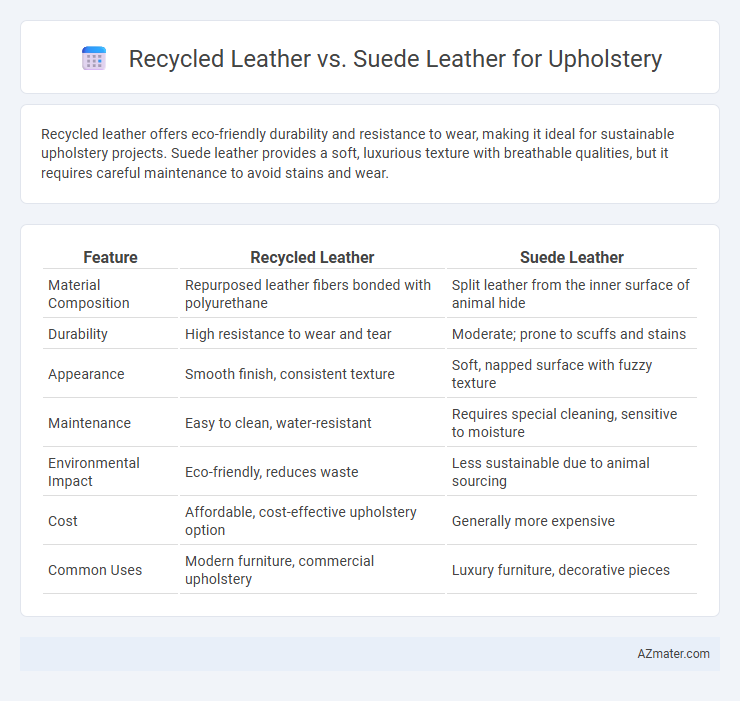Recycled leather offers eco-friendly durability and resistance to wear, making it ideal for sustainable upholstery projects. Suede leather provides a soft, luxurious texture with breathable qualities, but it requires careful maintenance to avoid stains and wear.
Table of Comparison
| Feature | Recycled Leather | Suede Leather |
|---|---|---|
| Material Composition | Repurposed leather fibers bonded with polyurethane | Split leather from the inner surface of animal hide |
| Durability | High resistance to wear and tear | Moderate; prone to scuffs and stains |
| Appearance | Smooth finish, consistent texture | Soft, napped surface with fuzzy texture |
| Maintenance | Easy to clean, water-resistant | Requires special cleaning, sensitive to moisture |
| Environmental Impact | Eco-friendly, reduces waste | Less sustainable due to animal sourcing |
| Cost | Affordable, cost-effective upholstery option | Generally more expensive |
| Common Uses | Modern furniture, commercial upholstery | Luxury furniture, decorative pieces |
Introduction to Recycled Leather and Suede Leather
Recycled leather, produced from shredded genuine leather scraps bonded with polyurethane or latex, offers an eco-friendly and cost-effective alternative for upholstery, boasting durability and a leather-like appearance. Suede leather, created by sanding the inner surface of animal hides, presents a soft, napped texture renowned for its luxurious feel but demands careful maintenance due to its susceptibility to stains and wear. Both materials serve distinct upholstery purposes, balancing sustainability, aesthetics, and practicality in interior design.
Defining Recycled Leather: Composition and Manufacturing
Recycled leather upholstery consists of shredded leather fibers bonded with polyurethane or latex binders, offering a sustainable alternative to traditional leather by repurposing leather waste. This composite material undergoes processes such as grinding, blending, and coating, resulting in a durable, eco-friendly fabric with reduced environmental impact. The manufacturing of recycled leather emphasizes waste reduction and resource efficiency, making it a preferred choice in sustainable interior design compared to conventional suede leather.
Suede Leather: Characteristics and Sourcing
Suede leather, derived from the inner split of animal hides, offers a soft, napped texture that enhances upholstery with a luxurious feel and enhanced grip, making it ideal for furniture requiring both comfort and style. Its porous surface absorbs dyes effectively, resulting in rich, vibrant colors, and it requires careful sourcing from sustainably managed tanneries adhering to eco-friendly practices to minimize environmental impact. Compared to recycled leather, suede demands more specialized maintenance to preserve its delicate texture while providing a unique, tactile appeal favored in high-end interior design.
Visual Appeal: Texture and Aesthetic Differences
Recycled leather offers a smooth, consistent texture with a polished finish that enhances modern and minimalist upholstery designs, while suede leather provides a soft, napped surface that introduces warmth and a tactile, luxurious feel. The visual appeal of recycled leather often includes subtle grain variations and a slightly glossy sheen, contrasting with suede's matte, fuzzy appearance that absorbs light differently, creating depth and richness. Choosing between recycled leather and suede for upholstery depends on desired aesthetic outcomes--sleek elegance versus cozy sophistication--each influencing the room's ambiance and style perception.
Durability and Longevity Comparison
Recycled leather, made from shredded leather fibers bonded with polyurethane, offers moderate durability but tends to wear and crack faster than genuine suede leather. Suede, derived from the underside of animal hides, provides a softer texture with higher resistance to abrasion and longer-lasting resilience when properly maintained. Upholstery using suede leather typically benefits from enhanced longevity and durability compared to recycled leather options.
Maintenance and Cleaning Requirements
Recycled leather upholstery requires minimal maintenance with regular dusting and occasional wiping using a damp cloth, resisting stains better than suede due to its coated surface. Suede leather demands more delicate care, needing specialized suede brushes and cleaners to maintain its texture and prevent water damage or staining. Choosing recycled leather offers greater durability for high-traffic areas, while suede requires attentive upkeep to preserve its soft, luxurious feel.
Environmental Impact of Both Materials
Recycled leather, made from repurposed leather scraps, significantly reduces landfill waste and lowers demand for new animal hides, contributing to decreased carbon emissions and water usage compared to traditional leather production. Suede leather, derived from the underside of animal hides, requires extensive processing involving chemicals and water, which can result in higher environmental pollution and resource consumption. Choosing recycled leather upholstery supports circular economy principles and offers a more sustainable alternative to the resource-intensive and chemically treated suede leather.
Cost Analysis: Recycled vs. Suede Leather
Recycled leather offers a cost-effective alternative to traditional suede leather for upholstery, typically priced 20-40% lower due to the use of repurposed materials and less intensive processing. Suede leather, derived from the underside of animal hides, involves higher production costs attributed to labor-intensive tanning and finishing techniques that enhance its soft texture and aesthetic appeal. Choosing recycled leather significantly reduces overall expenditure while still providing durability and a leather-like appearance, making it an economically advantageous option for budget-conscious upholstery projects.
Comfort and Feel in Upholstery Applications
Recycled leather offers a smooth, uniform feel with a firmer texture ideal for durable upholstery, while suede leather provides a soft, plush surface that enhances comfort with its velvety nap. Upholstery using recycled leather benefits from eco-friendly properties and easy maintenance, whereas suede excels in luxurious tactile experiences but requires careful upkeep to maintain its softness. Both materials contribute distinct comfort levels, with suede favored for intimate seating areas and recycled leather preferred for high-traffic environments.
Best Uses: When to Choose Recycled or Suede Leather
Recycled leather excels in upholstery for eco-conscious spaces, offering durability and a unique texture ideal for high-traffic areas like office chairs and commercial seating. Suede leather provides a luxurious, soft finish suited for low-traffic, decorative pieces such as accent chairs and elegant sofas where tactile comfort is prioritized. Opt for recycled leather when sustainability and resilience are key, while suede leather is best chosen for style-focused applications requiring a delicate, matte appearance.

Infographic: Recycled leather vs Suede leather for Upholstery
 azmater.com
azmater.com